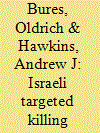| Srl | Item |
| 1 |
ID:
173845


|
|
|
|
|
| Summary/Abstract |
This article offers a contextualized comparison of Israeli targeted killing operations aimed at Palestinian high value targets before and during the Second Intifada. Utilizing four indicators that can be directly attributed to a particular operation (elimination of the intended target, civilian and non-target casualties, directly-linked retaliatory attacks, and adverse political consequences), we analyzed thirty-eight Israeli targeted killing operations to determine whether the policy changes introduced during the Second Intifada (regarding the scale, legal basis, and targeting methods) resulted in increased operational success. Our findings indicate that according to all but the first indicator, Israeli targeted killing operations conducted during the Second Intifada were less successful than those conducted prior to this conflict.
|
|
|
|
|
|
|
|
|
|
|
|
|
|
|
|
| 2 |
ID:
141293


|
|
|
|
|
| Summary/Abstract |
Targeted killing operations conducted outside Afghanistan have prompted debate regarding their lawfulness. For opponents of targeted killing operations, the debate tends to center on the number of civilians killed. Proponents respond by questioning the credibility and validity of the methods employed to determine the number of civilian casualties. This debate is important, but it also obscures the fact that the lawfulness of targeting killings is not determined by whether civilians were killed alone, while also lending legitimacy to unsubstantiated claims that the United States is engaged in an armed conflict with Al Qaeda and “associated forces.” This article classifies the hostilities in Pakistan, Yemen, and Somalia. It then applies the applicable body of law to targeted killing operations in each of these respective states based on how the hostilities were classified.
|
|
|
|
|
|
|
|
|
|
|
|
|
|
|
|